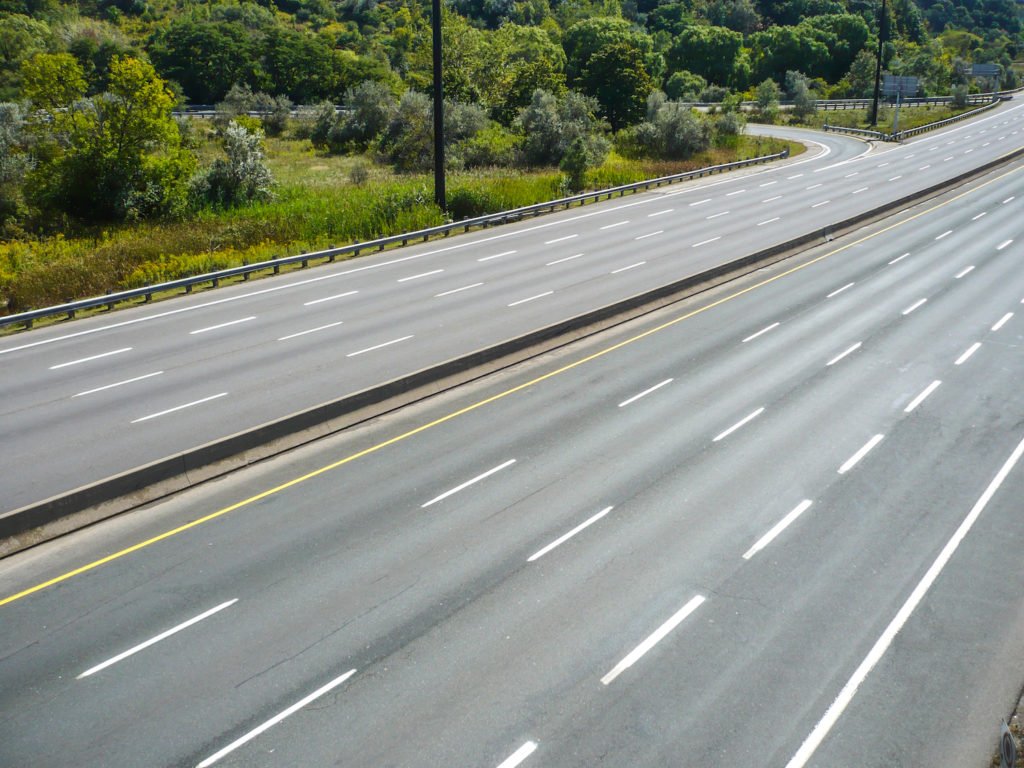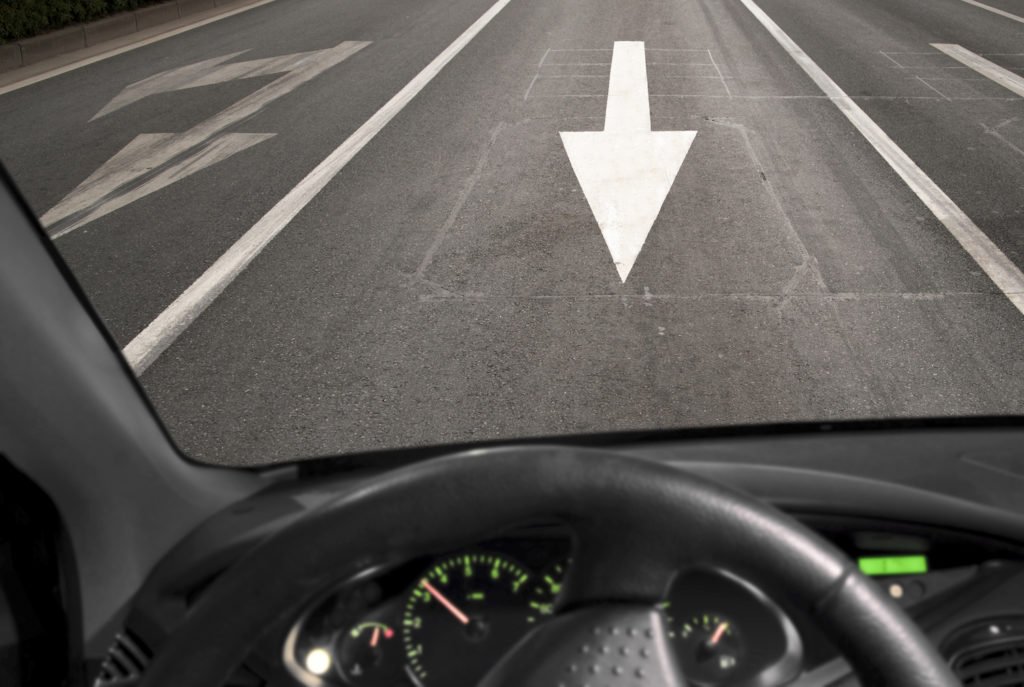CRS 42-4-1010 is the Colorado traffic law that requires motorists to drive on the right side of divided or controlled-access highways. Driving on the wrong side (against traffic) is a class A traffic infraction, which carries a civil fine of up to $100 and four DMV points. But motorists could also face more serious charges of reckless driving (CRS 42-4-1401), which carries jail time.
The statute states:
(1) Whenever any highway has been divided into separate roadways by leaving an intervening space or by a physical barrier or clearly indicated dividing section so constructed as to impede vehicular traffic, every vehicle shall be driven only upon the right-hand roadway, unless directed or permitted to use another roadway by official traffic control devices. No vehicle shall be driven over, across, or within any such dividing space, barrier, or section, except through an opening in such physical barrier or dividing section or space or at a crossover or intersection as established, unless specifically prohibited by official signs and markings or by the provisions of section 42-4-902.
Below our Denver Colorado criminal defense lawyers discuss:
- 1. What does CRS 42-4-1010 do?
- 2. What are the penalties for driving on the wrong side of a divided highway?
- 3. What can a Colorado criminal defense attorney do?
- 4. What happens if I ignore the ticket?
- 5. Is driving against traffic probable cause for a DUI stop?
- 6. Can I sue a driver for going against traffic?

CRS 42-4-1010 requires Colorado motorists to drive to the right side of the median on a divided highway.
1. What does CRS 42-4-1010 do?
CRS 42-4-1010 prohibits people from driving on the left side – against traffic – on divided or controlled-access highways in Colorado. These are roadways with a median or other divider meant to impede traffic from crossing over.
In short, it is illegal to drive on the wrong side of the road. And it does not matter if there are no oncoming cars at the time.1
2. What are the penalties for driving on the wrong side of a divided highway?
Violating CRS 42-4-1010 is a class A traffic infraction. The punishment includes fines from $15 to $100 plus a small surcharge. In addition, the DMV will add four (4) points to the driver’s license. (For adults 21 and older, getting 12 points in one year will cause an automatic license suspension.)2 Since it is a moving violation, drivers may see an increase in their car insurance premiums.
Police typically pull over and issue citations to drivers who commit traffic infractions. Since infractions are civil matters, they do not carry jail time.
But driving on the wrong side of the road is extremely dangerous, especially on high-speed divided highways. Therefore, motorists caught violating CRS 42-4-1010 may also be arrested for reckless driving, which is a class 2 misdemeanor traffic offense. A first-time conviction carries:
- Between 10 and 90 days in jail, and
- Up to $300 in fines.
Subsequent convictions carry up to:
- Up to 6 months in jail, and
- Up to $1,000 in fines.
Reckless driving also causes eight (8) DMV points to be added to the person’s license. Note that commercial driver’s license holders face a 60-day suspension of their CLD for committing two “serious” traffic violations in a commercial vehicle in a 3-year time frame. Reckless driving qualifies as one of these serious violations.3
3. What can a Colorado criminal defense attorney do?
A criminal defense lawyer will search for all the available evidence, which typically includes surveillance video, eyewitness accounts, GPS records, and weather reports. Depending on the case, potential defenses to fight CRS 42-4-1010 charges include arguing that:
- There was an emergency situation that justified the defendant driving on the wrong side of the road. Perhaps a dangerous driver was chasing the defendant, or perhaps a flash flood or debris made driving on the right side unsafe. The defense attorney would then try to show that any reasonable person in the defendant’s position would have resorted to driving on the wrong side of the road.
- The driver was falsely accused by someone else. It is not unusual for people to hurl untrue accusations at someone out of anger or revenge. It may also be possible to impeach the accuser’s credibility and reveal his/her motivations for lying.
- The police made a mistake. Perhaps law enforcement arrested or cited the wrong person. Here, dashcam footage would serve as valuable evidence to exonerate the defendant.
Note that it is not a defense that there was no oncoming traffic at the time the defendant was driving on the left side of the divided highway.

People caught driving against traffic in Colorado will probably be arrested for reckless driving since it is so dangerous.
4. What happens if I ignore the ticket?
Not paying a traffic ticket will cause the DMV to suspend the person’s driver’s license until the debt is paid (usually after a 30-day grace period). And the court will take a default judgment out against the defendant in the amount of the unpaid fine.4
But if prosecutors bring reckless driving charges, defendants risk getting a bench warrant if they miss court. This is because reckless driving is a criminal – not civil – case. And once a bench warrant is out, defendants are vulnerable to being arrested at any time. A criminal defense attorney would then ask the court to quash (recall) the warrant, which usually requires a hearing before the judge.
5. Is driving against traffic probable cause for a DUI stop?
Driving in violation of CRS 42-4-1010 is certainly an indication that the motorist may be impaired by drugs or alcohol. During the traffic stop, police would likely put the driver through a preliminary breath test and field sobriety tests. And depending on how the driver performs, the police may have probable cause to make a DUI or DWAI arrest.
6. Can I sue a driver for going against traffic?
Yes, car accident victims may sue the at-fault motorist (defendant) for negligence per se. Should the case go to trial, the victim (plaintiff) would need to prove that:
- The defendant violated a traffic law (by going against traffic);
- The purpose of this traffic law was to safeguard people like the plaintiff (other drivers);
- The plaintiff’s injuries were caused by the defendant’s violation; and
- The injuries caused financial damages.
Most cases never reach trial. Instead, the plaintiff’s Colorado personal injury lawyer would try to negotiate a settlement out of court. The goal would be to recover sufficient compensatory damages to pay for all of the plaintiff’s injuries, which includes not only medical bills but also any lost wages and pain and suffering.
In California? See our article on going against traffic (VC 21651(b)).
Legal references:
- Colorado Revised Statutes 42-4-1010 CRS – Driving on divided or controlled-access highways. The full language of the case section reads:
(1) Whenever any highway has been divided into separate roadways by leaving an intervening space or by a physical barrier or clearly indicated dividing section so constructed as to impede vehicular traffic, every vehicle shall be driven only upon the right-hand roadway, unless directed or permitted to use another roadway by official traffic control devices. No vehicle shall be driven over, across, or within any such dividing space, barrier, or section, except through an opening in such physical barrier or dividing section or space or at a crossover or intersection as established, unless specifically prohibited by official signs and markings or by the provisions of section 42-4-902. However, this subsection (1) does not prohibit a left turn across a median island formed by standard pavement markings or other mountable or traversable devices as prescribed in the state traffic control manual when such movement can be made in safety and without interfering with, impeding, or endangering other traffic lawfully using the highway.
(2)(a) No person shall drive a vehicle onto or from any controlled-access roadway except at such entrances and exits as are established by public authority.
(b) Wherever an acceleration lane has been provided in conjunction with a ramp entering a controlled-access highway and the ramp intersection is not designated or signed as a stop or yield intersection as provided in section 42-4-703(1), drivers may use the acceleration lane to attain a safe speed for merging with through traffic when conditions permit such acceleration with safety. Traffic so merging shall be subject to the rule governing the changing of lanes as set forth in section 42-4-1007(1)(a).
(c) Wherever a deceleration lane has been provided in conjunction with a ramp leaving a controlled-access highway, drivers shall use such lane to slow to a safe speed for making an exit turn after leaving the mainstream of faster-moving traffic.
(3) The department of transportation may by resolution or order entered in its minutes and local authorities may by ordinance consistent with the provisions of section 43-2-135(1)(g), C.R.S., with respect to any controlled-access highway under their respective jurisdictions, prohibit the use of any such highway by any class or kind of traffic which is found to be incompatible with the normal and safe movement of traffic. The department of transportation or the local authority adopting such prohibitory regulations shall install official traffic control devices in conformity with the standards established by sections 42-4-601 and 42-4-602 at entrance points or along the highway on which such regulations are applicable. When such devices are so in place, giving notice thereof, no person shall disobey the restrictions made known by such devices. This subsection (3) shall not be construed to give the department authority to regulate pedestrian use of highways in a manner contrary to the provisions of section 42-4-805.
(4) Any person who violates any provision of this section commits a class A traffic infraction.
- CRS 42-2-127(5)(h).
- 49 C.F.R. 383.51.
- CRS 42-4-1709; also see our article on driving with a suspended license / driving under restraint (CRS 42-2-138).
